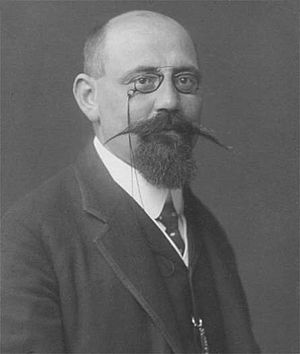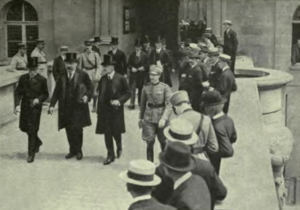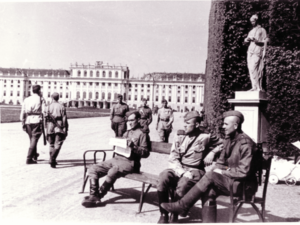Karl Renner facts for kids
Quick facts for kids
Karl Renner
|
|
|---|---|

Karl Renner c.1905
|
|
| President of Austria | |
| In office 20 December 1945 – 31 December 1950 |
|
| Chancellor | Leopold Figl |
| Preceded by | Wilhelm Miklas (1938) |
| Succeeded by | Theodor Körner |
| Chancellor of Austria | |
| In office 27 April 1945 – 20 December 1945 |
|
| Vice-Chancellor | Leopold Figl Johann Koplenig Adolf Schärf |
| Preceded by | Arthur Seyss-Inquart (1938) |
| Succeeded by | Leopold Figl |
| In office 21 October 1919 – 7 July 1920 |
|
| Vice-Chancellor | Jodok Fink |
| Preceded by | Himself as Chancellor of German-Austria |
| Succeeded by | Michael Mayr |
| Chancellor of German-Austria | |
| In office 30 October 1918 – 21 October 1919 |
|
| Appointed by | State Council |
| Vice-Chancellor | Jodok Fink |
| Preceded by | Office established |
| Succeeded by | Himself as Chancellor of Austria |
| President of the National Council | |
| In office 29 April 1931 – 4 March 1933 |
|
| Preceded by | Matthias Eldersch |
| Succeeded by | Leopold Kunschak (1945) |
| Minister of Foreign Affairs | |
| In office 26 July 1919 – 22 October 1920 |
|
| Preceded by | Otto Bauer |
| Succeeded by | Michael Mayr |
| Minister of the Interior and Education | |
| In office 15 March 1919 – 9 May 1919 |
|
| Succeeded by | Matthias Eldersch |
| Preceded by | Heinrich Mataja (Interior) Raphael Pacher (Education) |
| Personal details | |
| Born | 14 December 1870 Unter-Tannowitz, Austria-Hungary (now Dolní Dunajovice, Czech Republic) |
| Died | 31 December 1950 (aged 80) Vienna, Austria |
| Political party | Social Democratic Workers' Party |
| Spouse | Luise Renner |
| Occupation | Jurist |
Karl Renner (born December 14, 1870 – died December 31, 1950) was an important Austrian politician and lawyer. He was a member of the Social Democratic Workers' Party of Austria. Many people call him the "Father of the Republic." This is because he led the first government of German-Austria and the First Austrian Republic in 1919 and 1920. He was also key in setting up the current Second Republic after Nazi Germany was defeated in 1945. After World War II, he became Austria's first President.
Contents
Early Life and Education
Karl Renner was born in a small village called Unter-Tannowitz, which is now in the Czech Republic. He was the 18th child in a family of poor wine-growers. Because he was very smart, he was able to go to a special high school called a gymnasium.
From 1890 to 1896, he studied law at the University of Vienna. In 1895, he helped start an organization called Friends of Nature (German: Naturfreunde). He even designed their logo.
Starting a Political Career
In 1896, Renner joined the Social Democratic Workers' Party of Austria (SDAP). He represented the party in the National Council from 1907 until 1918. During this time, he also started and edited the party's magazine, Der Kampf.
Renner was very interested in how countries should be run. He studied the problems of the Austrian state and believed it should exist for good reasons like geography and economy. He also had ideas about how different groups of people within a country could live together peacefully. He was known as a leader of a group called Austro-Marxism.
Leading the First Republic
Forming a New Nation
After the Austro-Hungarian Empire fell apart in 1918, Karl Renner played a big role. He helped create a new, small German-speaking republic. This new country wanted to be called the Republic of German-Austria. However, the countries that won World War I (called The Entente) did not allow this name. They also stopped "German-Austria" from joining the German Weimar Republic.
Renner had actually supported the idea of German-speaking parts of Austria joining with Germany even before the empire collapsed. He believed that joining Germany was the best path for Austria.
Signing the Treaty of Saint-Germain

Renner led the group that represented this new Austria at the St. Germain talks. Here, the "Republic of Austria" was officially recognized. However, Austria was also held responsible for the old empire's actions. Renner had to accept that Austria could not join Germany. He also had to accept that Austria would lose German-speaking areas like South Tyrol and parts of Bohemia and Moravia. This meant he lost his family's farm in his birth region.
Social Reforms and Parliament
Renner served as Chancellor of Austria from 1918 to 1920. During this time, he was also the Minister of Foreign Affairs. His government, supported by both Social Democrats and the Christian Social Party, brought in many important social changes. These included:
- Unemployment insurance
- Paid holidays
- The eight-hour workday
- Rules for working conditions for miners, bakers, women, and children
- Health insurance for public workers
- Laws for fair negotiations between workers and employers
From 1931 to 1933, Renner was the President of the Austrian Parliament, the National Council of Austria.
Austria During World War II
Views on the Anschluss
After Austria became a dictatorship in 1934, Renner's party was banned. When Nazi Germany took over Austria in 1938 (an event called the Anschluss), Renner actually welcomed it. He thought that the Nazi rule would be temporary. He believed it would not be worse than the dictatorship Austria had just experienced. However, during World War II, he stepped away from politics completely.
On April 2, 1938, Renner asked Austrians to vote "yes" in a public vote that made the Anschluss official. Many Austrians followed his advice. After the Anschluss, Renner even offered to work for the Nazi government, but his offer was turned down.
Working with the Soviets
In March 1945, Soviet troops entered Austria. On April 3, Renner, who was living in southern Austria, contacted the Soviets. The Soviet leader, Joseph Stalin, had planned to set up a government with Austrian communists who were living in exile. However, a telegram from a Soviet commander changed Stalin's mind in favor of Renner.
On April 20, 1945, the Soviets asked Renner to form a temporary government. A week later, Renner's government took office. They declared Austria's independence from Nazi Germany. They also called for a democratic country, similar to the First Austrian Republic.

Renner's government included members from different parties. One-third of his cabinet, including important roles like the Secretary of State of the Interior and the Secretary of State for Education, were Austrian Communists. The Western countries were suspicious. They thought Austria might become a puppet state controlled by the Soviets. They did not officially recognize Renner's government at first. However, Renner made sure that different parties had control by having two Under-Secretaries of State in each ministry, chosen by the other parties.
Some historians believe that Renner's quick action in getting Soviet support for a democratic Austrian Republic saved Austria. Without him, Austria might have been divided into a Communist East Austria and a democratic West Austria, like Germany was after the war.
After World War II
Renner's government decided to bring back Austria's 1920 Constitution, with some changes made in 1929. After elections in November 1945, Karl Renner was elected as President on November 20. He died in 1950 in Vienna and was buried in the Presidential Tomb at the Zentralfriedhof.
Controversial Views
After World War I and even after World War II, some leaders in Austria held difficult views towards certain groups of people. Karl Renner, for example, had controversial opinions. A survivor of a concentration camp, Marko Feingold, stated in 2013 that Renner was known for his unwelcoming stance towards Jewish people who had survived the war and wished to return to Vienna. Feingold said that Renner did not want them in Vienna and stated that Austria would not return their property. This shows that Renner's views and actions were seen as unfair and unwelcoming by some who had suffered greatly.
Ideas and Contributions

For most of his life, Renner was both a politician and a scholar. He was very interested in how private laws and private property work together. In his 1904 book, The Institutions of Private Law and their Social Functions, he helped create the study of the sociology of law. In this book, Renner explored how private law can sometimes serve the interests of powerful property owners.
His ideas about protecting the rights of different cultural groups were used by some Jewish groups. However, leaders like Vladimir Lenin and Joseph Stalin strongly disagreed with these ideas.
The 1977–1978 school year at the College of Europe was named in his honor.
See also
 In Spanish: Karl Renner para niños
In Spanish: Karl Renner para niños
- Allied-administered Austria
- National personal autonomy

